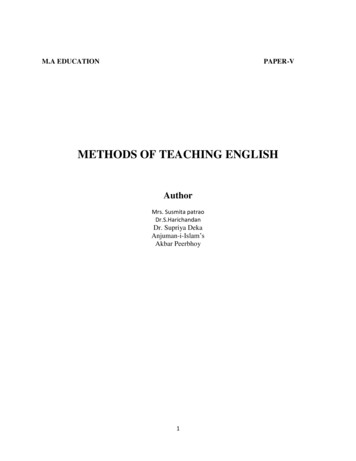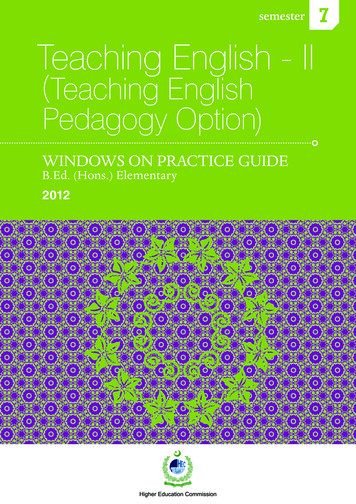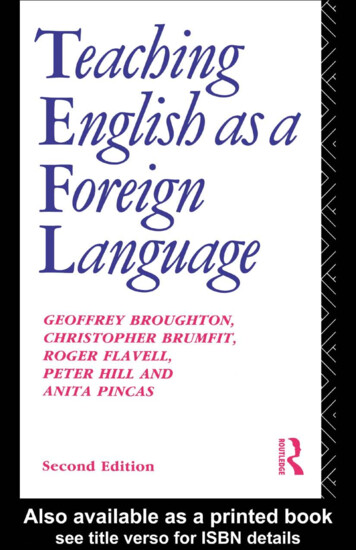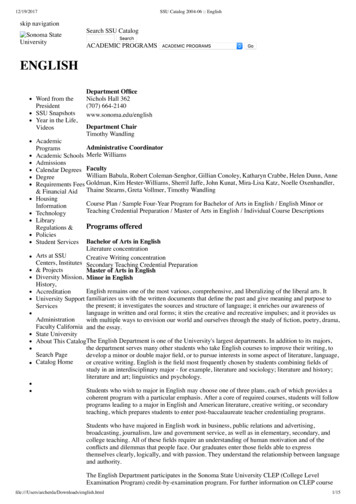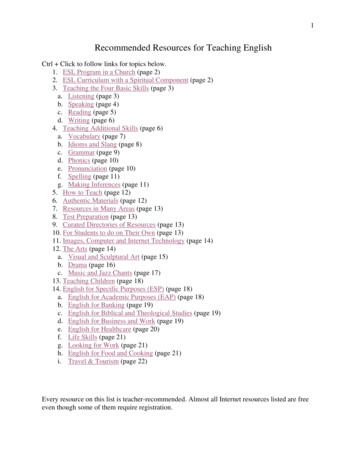
Transcription
1Recommended Resources for Teaching EnglishCtrl Click to follow links for topics below.1. ESL Program in a Church (page 2)2. ESL Curriculum with a Spiritual Component (page 2)3. Teaching the Four Basic Skills (page 3)a. Listening (page 3)b. Speaking (page 4)c. Reading (page 5)d. Writing (page 6)4. Teaching Additional Skills (page 6)a. Vocabulary (page 7)b. Idioms and Slang (page 8)c. Grammar (page 9)d. Phonics (page 10)e. Pronunciation (page 10)f. Spelling (page 11)g. Making Inferences (page 11)5. How to Teach (page 12)6. Authentic Materials (page 12)7. Resources in Many Areas (page 13)8. Test Preparation (page 13)9. Curated Directories of Resources (page 13)10. For Students to do on Their Own (page 13)11. Images, Computer and Internet Technology (page 14)12. The Arts (page 14)a. Visual and Sculptural Art (page 15)b. Drama (page 16)c. Music and Jazz Chants (page 17)13. Teaching Children (page 18)14. English for Specific Purposes (ESP) (page 18)a. English for Academic Purposes (EAP) (page 18)b. English for Banking (page 19)c. English for Biblical and Theological Studies (page 19)d. English for Business and Work (page 19)e. English for Healthcare (page 20)f. Life Skills (page 21)g. Looking for Work (page 21)h. English for Food and Cooking (page 21)i. Travel & Tourism (page 22)Every resource on this list is teacher-recommended. Almost all Internet resources listed are freeeven though some of them require registration.
21. ESL Program in a Churcha. Resources from Cornerstone University’s 2016 ESL Conference. Scroll down toStarting and Developing an ESL Program by Michael Pasquale.i. PowerPoint Slidesii. Curriculum Handoutiii. Defining Mission Handoutiv. Demographics Surveyv. Energizer Activityvi. Phrase Craze Activityb. The Church of the Nazarene has a 8-page document, How to Start an English as aSecond Language (ESL) Outreach Ministry in Your Churchc. Book Available for Purchase: An ESL Ministry Handbook: Contexts andPrinciples by Michael Pasquale prepares novice teachers to meet an immediateteaching need and encourages them to develop their own philosophy of ESLministry.d. The Presbyterian Church in America Mission to North America has manyresources for Starting an ESL School2. ESL Curriculum with a Spiritual Componenta. Curricula Available for Purchase: Conversational English with Reach Globali. Three separate curricula for English ministries with youth and adults,Adventures in English, Discoveries in English, and Exploring English, thatcan be used by novice teachers.ii. Active English for Kids has seven conversation lessons for children 6-9that can be used by novice teachers. These print copies can be orderedfrom ReachGlobal.b. Resources from Cornerstone University’s 2016 ESL Conference Building Bridgesi. Scroll down to Biblical Themes for Language Learningii. Scroll down to Scattering Seed in Teachingc. Textbook Available for Purchase: Both the Student Workbook and the Teacher’sManual for English in Action by Wally Cirafesi are available from Navigators.d. Jan Dormer’s Page has ESL materials that you can download free and thenchange and edit as fits your teaching situation.i. English for Life is for youth and adults.ii. God is Good is for children.e. Open Bible Stories has 50 Bible stories in many languages. To locate the Englishresources, click on “English” to see how to access the stories by text, audio orvideo. The English videos can be viewed on YouTube.f. The PCAMNA offers a 10-page booklet on Introducing the Gospel in ESLPrograms which can be used with secular curriculums.g. Learn English Bible has Bible stories in The Bible in Basic English. For eachstory there are key words to look for as you read the story.h. Easy English Bible Studies are free downloads on various topics.
3i. The New Century Version and The New Life Version on Bible Gateway areuseful for English learnersj. Book Available for Purchase: What Christians Believe is a discipleship book fornew believers who are learning English.k. The PCA has a 10-page document Introducing the Gospel in ESL Programs toexplain how you can share the gospel while using secular materials to teachEnglish.3. Teaching the Four Basic SkillsSpeaking, listening, reading and writing are the foundational skills in acquiring alanguage.a. Listeningi. Storyline Online is courtesy of the Screen Actors Guild Foundation. Youcan listen to children’s story books read by actors and actresses.ii. To choose topics for your students to listen to, go to the Special Featuressection of This I Believe, where you’ll find the transcripts of the audiofiles. You can prepare questions and answers, or you can assign yourstudents a writing or speaking topic.iii. Randall’s ESL Cyber Listening Lab has quizzes and activities at threelevels: easy, intermediate, and difficult to improve students’ listeningcomprehension.iv. Voice of America offers a number of resources for learning English.1. Let’s Learn English is a video course that includes instruction inspeaking, vocabulary and writing. A student can follow this courseindependently, or it could be used as the content for a class.Lesson plans are provided for teachers who want to use thismaterial as their course content.2. Learning English Read, Listen & Learn offers audio files with anaccompanying English text.3. The VOA Learning English Word Book, a dictionary of the wordsused on the VOA website can be downloaded.v. A Framework for Planning a Listening Skills Lesson can be applied to anylesson. Listening well increases students’ ability to learn independently.vi. Learn English Feel Good offers online spelling and listening practicetests.vii. Easy Strategies for Teaching Listening focuses on two strategies: 1)demonstrating the difference between hearing and listening and 2)identifying common speech markers.
4b. Speaking (Teaching Tip: If you are the only fluent English speaker, you could usea puppet or doll to model the conversation.)i. Jones Library ESL Center Conversation Partner Guide provides guidancefor the volunteer English speaker working with an English learner.ii. Conversation Questions for the ESL/EFL Classroom, a project of TheInternet TESL Journal, has conversation questions for dozens of topicsfrom “Accidents at Home” to “Weekends”.iii. How to Get Your Students to Speak 100% English provides 13 tips tohave students speak in English as much as possible, which is about 9095% in his classes.iv. Early Rain/Speechtree provides topics for ESL conversations as long asyou don’t charge participants. The list of questions for each topic comeswith a related Bible passage.v. Ten Conversation Lessons with Stories, Vocabulary Practice, Questionsand Activities . tmlfrom The Internet TESL Journal and Ten More Conversation Lessons withStories, Vocabulary Practice, Questions and Activities also from TheInternet TESL Journal. tml The author recommends reading the story but it wouldbe even more effective if the teacher told the story and then had thestudents read the story. Telling a story allows eye contact, which enhancesattention.vi. Working the Weather: A Lesson Plan on Small Talk from TESOLconnections utilizes the YouTube video, The Art of Small Talk.vii. 7 Techniques that will Increase Student Speaking Time—Exponentiallyfrom Busy Teacher.
5c. Readingi. Adult Learning Activities from the California Distance Learning Projectoffers dozens of articles in 11 topics to improve reading and life skills.Each story can be read and listened to on several levels.ii. TV411 Tune into Learning offers videos that teach reading skills.iii. Print and Go offers free downloads of books that are short readings foradults. Beginning Level Book 3 Beginning Level Book 1iv. ESL Reading Comprehension from Excellent ESL 4U has a number ofexercises, vocabulary lists, tips and strategies to build students’comprehension.v. ESL Fast advertises itself as “A huge free online learning resource.” Itoffers 365 Essays for English Learners with audio files as well as text.vi. Easy Reading (1) and Easy Reading (2) are stories for adult learners thathave a text, and audio file, and additional activities. There are many morefree English resources at ESL: English as a Second Language.vii. Authorama provides free public domain books to read online.viii. Free Periodicals for ELLs1. The Times in Plain English, has tips for teachers for discussing thearticles.2. Breaking News English has audio and text versions of each storyon various levels. In addition, Breaking News English provides10 activities for each lesson. If you don’t have a textbook,Breaking News English could provide you with all the classroommaterials you need to teach a class.3. News in Levels has audio and text versions of each story on variouslevels. Both Breaking News English, and News in Levels provideaudio and text versions of each story on various levels.ix. This 31-page excerpt from New Ways in Teaching Reading includessample lesson plans and is geared toward teaching children.
6d. Writingi. Literacy Center offers beginning writing games and exercises gearedtoward children.ii. 1-Language.com offers Online ESL Writing Worksheets with interestingtopics.iii. Bogglesworld provides Creative Writing Worksheets and TeachingResources that are free for you to print.iv. ESL Galaxy provides Worksheets for Writing.v. First School Years presents a variety of Story Starters & Narrative WritingIdeas.vi. Purdue University Online Writing Lab (OWL) provides free lesson plans,guides and resources for teachers. There are also guides for doingresearch and organizing an essay.vii. The Capital Community College Foundation presents the Guide toGrammar and Writing a website that covers points of grammar and how towrite from the sentence level to the research paper level.viii. Kid Printables have resources appropriate for children who are EnglishLanguage Learners, including All About Me.ix. TESOL presents Six Games to Motivate Writing Students.4. Teaching Additional SkillsIn addition to the main skills of speaking, listening, reading and writing, there areadditional student skills for a teacher to address.
7a. Vocabularyi. There are many versions of The Oxford Picture Dictionary for purchase.You can download a free pdf of the New Oxford Picture Dictionary.Printing the index at the end of the book (pp. 106-124) would be a usefulreference if you use this regularly in your classroom.ii. On this one page, ESL Flow has English Vocabulary Worksheets thatprovide a wealth of topics, tools and teaching tips1. Teaching Vocabulary with Images2. Other Vocabulary Teaching Ideas for ESL Teachers3. Vocabulary Sorting4. More Advanced Vocabulary (IELTS, TOIEC or TOEFL Practice)5. Word Building & Word Formation Exercises & Worksheets6. Vocabulary Listsiii. Learn Prefixes, Suffixes to Expand Your Vocabulary from Voice ofAmerica lists the meaning of common suffixes and prefixes anddemonstrates how they are used.iv. The Vocab-O-Gram from the University of Virginia is a form for studentsto use key vocabulary from a story as they identify the story structure.v. YouGlish gives the pronunciation of English vocabulary words andphrases in different accents and in different contexts. The student types ina phrase, such as “Throw in the towel”, selects which accent she wants tohear and then gets results from YouTube video segments.vi. Using Pictures from Magazines describes how the teacher can utilizeimages to teach vocabulary as well as grammar, listening, conversationand writing. You could also use images from the Internet.vii. Reading Around the Room has young students reading the labels onobjects in the classroom.viii. Vocabulary Doesn’t Have to be a Bore describes Robert Marzano’s SixSteps of Vocabulary Acquisition and includes links to Internet platformsthat have resources to use in the classroom.ix. Boggle’s World ESL has many flashcards for learning vocabulary.x. Total Physical Response (TPR) is learning language through motions.1. Total Physical Response: A Curriculum for Adults is a freedownloadable guidebook from Spring Institute for InterculturalLearning.2. Genki English has videos and engaging ideas for using TPR toteach vocabulary.
8b. Idioms and Slangi. Effective Activities for Teaching English Idioms to EFL learners from TheInternet TESL Journal gives principles to follow when teaching idioms:teach in context, use idioms with illustrations and use group discussion toteach idioms.ii. Idiom Site has an alphabetical list of idioms and their meanings.iii. Language Success Press has lessons on a number of groups of idioms.They offer the lessons in idioms to advertise their books. You don’t haveto buy their books.iv. A4ESL has Self-Study Idiom Quizzes that include idioms, phrasal verbsand slang.v. Idiomatic Expressions to Use at Work from Espresso English wants you tosign up for their courses. You can use the resources on this page withoutdoing that.vi. The US Govt. Office of English Language Programs presents In the Loop:A Reference Guide to American English Idioms, a free downloadable 134page guide to idioms, definitions and classroom activities.vii. Illustrated Idioms are from English Work Group. Each idiom is definedand then illustrated in a humorous way.
9c. Grammari. ESL Flow has a page with links to resources for teaching grammar:Grammar Exercises and Worksheets, Parts of Speech Guides & Verb Listsfor ESL Teachers & Students, Brainstorming and Understanding Parts ofSpeech, Parts of Speech Exercises for ESL Students, Tenses andTimelines, and Verbs Review. Especially helpful are the Timelines toDemonstrate Present Perfect & Other Tensesii. Perfect English Grammar has effective explanations for all thingsgrammatical. Especially useful are the Tenses Infographics and theTenses Explanations.iii. Jane Straus wrote Blue Book of Grammar and Punctuation.GrammarBook.com has explanations of grammar and punctuation rules ofEnglish. You can also sign up for the e-newsletter—it’s like having agrammar refresher each week.iv. The Capital Community College Foundation presents the Guide toGrammar and Writing, which covers points of grammar and how to writefrom the sentence level to the research paper level.v. The Online Writing Lab at Purdue University has a number of webpagesdedicated to various aspects of writing. Links to their articles on grammarcan be found here.vi. TEFL.net gives ideas for presenting various aspects of grammar throughgames.vii. TESOL Connections has a list of grammar games to use in the classroom.viii. Irregular Verbs from English Page gives a list of over 370 irregular verbs,flashcard and exercises.ix. Wyzant’s Grammar Lessons & Help gives you lessons on the topics listedand quizzes to check understanding.x. English Grammar Guide from Education First is a page with links toarticles that form a complete guide to English grammar.xi. TESOL Connections explains How to Teach the Dummy Pronoun “It” inexpressions such as “It’s raining”.xii. Andromeda Jones in Crush it Teaching Phrasal Verbs in English gives amethod and the rationale behind it to present phrasal verbs (such as “takeon” and “put off” plus a list of 135 common phrasal verbs organized bypreposition. A useful resource to give to your students is The Big List ofPhrasal Verbs by Preposition.xiii. Reviewing English Grammar is a 30-page book that summarizes EnglishGrammar by Lynn Stapleton, CELTA, MA.xiv. Grammar Quizzes has quizzes to provide practice on points of grammar.xv. PDFDrive has two books by Michael Swan that you can download free.Practical English Usage is the grammar reference that not only explainsEnglish usage, it has examples from natural English. Some teachers havesaid that if they could only take one grammar book with them in theirsuitcases, this would be the book. Intermediate students who want toknow more about grammar could use Michael Swan’s Basic EnglishUsage. You could also buy hard copies of these books.
10xvi. All Things Grammar has 1000 worksheets on a variety of grammartopics.d. Phonicsi. Kiz Phonics has worksheets, games, video tutorials, listening by levels,phonics flashcards, phonemes cards sentence cards and more.ii. Fun Fonix has worksheet makers, worksheet templates, readingworksheets, exercises to print and games.iii. Starfall has free resources to encourage children to read using phonics.More resources are available if you choose to pay for an upgrade.iv. English is Soup! is a phonics resource for ESL adults that providesdocuments with diagrams for how the sound is produced, the usual lettersthat produce the sound as well as some of the exceptions.e. Pronunciationi. Lane’s English Pronunciation Guide by Richard R. Lane has diagrams anddescriptions for individual phonemes as well as minimal pairs with thetarget sound in initial, final and medial positions. The Lesson Formatexplains how to use this guide and the Teaching Hints alert the teacher tothe reasons why certain sounds are difficult for English learners topronounce and to distinguish.ii. Sounds of Speech from The University of Iowa presents two video filesfor each English phoneme. One is an animated side view that shows howthe different parts of the mouth move as the sound is produced. The otheris a view of a person’s face that shows how the lips move as the sound isproduced. The site is free, but you may need to register to access thecontent.iii. Professor Evan Ashworth of the University of British Columbia presentsIntroduction to the International Phonetic Alphabet, which is a goodresource for learning the IPA symbols for North American English. In thevideos Introduction to Articulatory Phonetics (Consonants) andIntroduction to Articulatory Phonetics (Vowels) he uses animated videosto show how the parts of the vocal tract move during the production ofsounds.iv. Teaching Pronunciation: Using the Prosody Pyramid by Judy Gilbert is a32-page book that covers the fundamentals of teaching pronunciation,providing practical tips and techniques for teaching rhythm, intonation andstress.v. Master the Sounds of American English is a video course from Rachel’sEnglish that demonstrates to the student how to make each sound,understand how stress changes sounds and how to make the phoneticsymbol for each soundvi. English With Stacy is Stacy Hagen’s YouTube channel with many videoson intonation, stress, rhythm, and understanding fast English.
11vii. American English Pronunciation Practice has audio and video minimalpair practice and quizzes, “listen and repeat” videos, “L” and “R”distinction, R-controlled vowels, focused vowels, and consonant clusters.viii. ESL Flow presents pronunciation exercises and worksheets for varioustopics such as pronunciation of final “s” and “th”, word stress exercises,pronunciation of final “ed” and “ch”ix. English Club has many resources for pronouncing British English.x. Sharon Widmayer and Holly Gray host the Sounds of English website tohelp students understand how stress and intonation make them moreintelligible.xi. Lynn Henrichsen presents 21 Online Pronunciation Resources forTeaching and Learning.xii. Adrian Underhill teaches the phonemic chart of British Pronunciation inIntroduction to Teaching Pronunciation, a one-hour workshop.f. Spellingi. Make spelling more fun in the classroom with 8 ESL Spelling Games fromFluentU. Caution: FluentU will try to get you to subscribe. You don’thave to.ii. 10 Fun Spelling Games for Your ESL Class from Busy Teacher.iii. 13 ESL Spelling Games from Teach This ESL/EFL Resources have lessonplans available as free downloads.iv.Top 4 Spelling Tricks for English Language Learners from Busy Teacher.
12g. Making Inferencesi. What Happened to the Bird? by Debra Josephson Abrams gives teachers alesson for using other videos to teach students about making inferences.ii. Inference Worksheets are on three different grade levels: 4-5, 6-8, and 912.iii. Teaching Inference is a lesson plan for university students who are at theintermediate level.5. How to Teacha. Book Available for Purchase: More Than a Native Speaker: An Introduction toTeaching English Abroad by Don Snow and Maxi-Ann Campbell prepares thenovice teacher to teach abroad with principles of language learning, skills thestudents need to acquire, the teacher’s cultural adaptation, books for furtherlearning, and Internet resources for teachers and students.b. Basic Training and Resources for Teaching English to Speakers of OtherLanguages (BTR-TESOL) is a free website for novice teachers. It provides basictraining (“the least you should know”) and resources (“where to go to learnmore”) for those who don’t have training to teach English.c. Teaching Guide: ESL Volunteer Guide from Writing@CSU at Colorado StateUniversity. The general content is helpful, but many of the links are no longeractive.d. What Should Every ESL Teacher Know? can viewed online. This practical bookcovers how to teach the four basic skills, how to design lessons and how to dealwith teaching challenges.
13e. Making It Real: Teaching Pre-literate Adult Refugee Students can be downloadedfrom Literacy Now, the Literacy Network of Washington, a Division of TacomaCommunity House.f. Book Available as a Free Download: Teaching English to Children by WendyScott & Lisbeth Ytreberg is part of the Longman Keys to Language Learningseries. This book has a lot of games and activities that are fun for children as theylearn to read, write, speak and listen to English.g. Book Available for Purchase: Teaching English to Children in Asia by David Paulpromotes the theory and practical applications of child-centered teaching. It is aneffective resource for teachers in other parts of the world.6. Authentic Materialsa. Carol Rueckert gives a list of authentic materials that you can use in the ESLclassroom.b. Carolyn Ebel Chandler gives activities for ESL students at different levels inUsing Newspapers in the ESL Literacy Classroom.c. Connie Chow writes about an Authentic Cooking Experience (ESL Activity) whichrequires students to follow directions from packages.d. Ideas for Using Authentic Texts with Low-level ESL Classes lists various realiaand how they can be used.e. Effective Ways to Use Authentic Materials with ESL/EFL Students from TheInternet TESL Journal gives suggestions on the use of authentic materials.7. Resources in Many Areasa. PDFDrive has books that you can download free as a pdf.b. Thought Co. has articles, worksheets and exercises on a variety of topics.c. English Club claims to be the world’s premier free educational website forlearners and teachers of English.d. TEFL.net has lesson plans, classroom ideas, worksheets and articles for teachers.e. The Idea Cookbook under Stuff for Teachers at Dave’s ESL Café will give youideas on whatever you’re searching for, be it grammar, math, or listeningf. The Internet TESL Journal was published 1995-2010 and is now a resource forarticles, lessons and techniques.g. Learn English Feel Good has quizzes and worksheets for grammar, listening andvocabulary.h. Sticky Ball has printable worksheets, grammar exercises, writing exercises, andmany more resources.i. English Store has free English tests and exercises online for grammar, reading,vocabulary, listening, speaking, A2 and PET-B1 Levels from the CommonEuropean Framework of Reference (CEFR), TOEFL, and TOEIC. There are alsosome tests you can download and complete offline.j. ESL Games World is designed to be the most interactive site for ESL classroomand self-study of English. It has games to develop student skills in grammar,vocabulary, pronunciation and reading.
14k. All Things Topics has vocabulary pages, worksheets, activities, reading, andconversation for many topics.l. My English Pages has resources for vocabulary, speaking, reading, listening,writing.8. Test PreparationThis material will be added later.9. Curated Directories of Resourcesa. Southern Ontario Cooperative for ESL Ministries has a variety of resources forESL conversation lessons, ESL Bible study, pronunciation, grammar, seasonalresources, and ESL for seniors.b. Top 20 English is a curated Internet directory, a multiple search tool, and an appdirectory.c. Most of the links for Jurgen Wagner’s ESL Teacher’s Toolkit are active, but notall of them.d. The ESL Resources site of the EFCA requires registration to access theirmaterialse. Larry Ferlazzo has 2000 categorized “Best” Lists from his blog. When someoneneeds a particular resource, Larry’s website is a great place to start.10. For Students to do on Their Owna. Many Things has a variety of activities for students to do on their own.b. Activities 4 ESL has quizzes, tests, exercises and puzzles to help students learnEnglish.c. ESL Independent Study Lab has a collection of what they say are over 250 of thebest Internet resources for ESL/EFL students.11. Images, Computer and Internet Technologya. Larry Ferlazzo’s The Best Online Sources for Images was posted in 2008 andmany of the links still work.b. Find Images Without Copyright by Russell Stannard takes you through some ofthe best sites for free images you can use legally.i. Clipart.com has royalty-free images.ii. Russell recommends using “albums” to search for the picture you want onELTPics.com.iii. Pixabay.com does not require attribution but it’s a nice thingiv. ESL Flashcards has lots of PDF images.c. Ideas for Teaching Digital Citizenship: #1 Copyright by Russell Stannarddemonstrates how to use Google Images to focus on finding the right image. Youcan filter your image searches by usage rights to be sure you can use it legally.d. Nik Peachey’s Learning Technology Blog For English Language Teachers has ebooks and blog posts to equip English teachers to use technology well. One of his
15most popular and practical posts is, “12 Tips for Training Older Teachers to UseTechnology.” Nik also has a newsletter that you can subscribe to.e. Teacher Training Videos is Russell Stannard’s platform to provide free trainingfor teachers in Internet technology. His motto is, “Making Tech Easy forTeachers,” and he delivers on that promise.12. The ArtsWhen it comes to language learning, utilize resources beyond the expected paper, pencilsand books.a. Visual and Sculptural ArtOne of the shared characteristics of all people is that they respond to visual andsculptural art. For a given painting, some people may love it, some people may hate it,and some people may be neutral toward it. They all have a reaction and an Englishclass can give them opportunity to express that reaction. They can describe a picture—what colors they see, what things they see, and what actions they see. They can drawinferences from the painting, explaining what they think has happened and what theythink will happen next.i. Language Through Art: An ESL Enrichment Program (Intermediate/Advanced Level) from the J. Paul Getty Museum has lesson plans plustips for teaching about portraits, landscapes and narrative art.ii. Art in the Classroom uses art to provide opportunities for using language.
16iii. The Best Resources for Using Art as a Way to Teach and Learn Englishby Larry Ferlazzo presents his list of six plus additional sites provided byother teachers who commented on his blog post. All of these links workedon August 28, 2019.iv. A free download from American English is Create to Communicate: ArtActivities for the English as a Foreign Language Classroom. This bookuses art to enhance the four basic skills—reading, writing, speaking andlistening. It connects language objectives with art concepts, offeringenrichment to the student and teacher.v. Art as a Tool for Teachers of English Language Learners recognizes thatknowledge of the arts is essential to a well-rounded education. Makingthe arts part of classroom instruction will benefit students from diverselinguistic and cultural backgrounds.vi. Meaningful Creations: 5 Amusing Art Activities for Eager ESL Studentsgives directions on this page for activities that will enhance Englishlanguage skills. Just a caution about all FluentU pages: don’t feelpressured to subscribe to Fluent U. You can benefit from their blog postswithout doing that.Photo 9 of 12 on this siteb. DramaDrama gives students a safe place to practice language for situations they will face inthe real world. It can contribute to life skills since the students experience differentpoints of view. It also gives them pronunciation practice by reciting the same linesmultiple times.i. The Best Resources on Using Drama in the Classroom by Larry Ferlazzohas links to 11 websites related to using drama effectively in theclassroom.ii. Free ESL Materials.com lists 42 free websites for using drama in the ESLclassroom.
17iii. Dr. Andrew Finch at Finch Park.com offers drama scripts to teach Englishthrough literature.iv. E-Book for Purchase: Fun ESL Role-Plays and Skits for Children Aged 412 by Shelley Ann Vernon is a way to teach English through drama. Thisis one of the few online resources listed that requires purchasing. It isincluded here because it has been judged to be worth the price of 20.00 todownload it.v. Reader’s Theater Scripts and Plays can be downloaded from AaronShepherd’s Reader’s Theater page.vi. Reading Rockets has links to Reader’s Theater lesson plans and scripts.c. Music and Jazz ChantsMusic is a great way for students to learn and use new sounds, words and phrases.Songs that feature the first and second person, contain words that occur often, andrepeat those words engage students in a way that prose does not.i. The Children’s Music Network has three songbooks with lyrics and audiofor all of them—environmental songs, peace songs and multiculturalsongs.ii. Sing Out Loud Children’s Songs is a set of 13 traditional children’s songsfrom American English. You can download the lyrics and the audio.iii. The British Council has many songs for children to sing and get better atspeaking English.iv. Kristin Lems’ New Ideas for Teaching English Using Songs and Mu
free English resources at ESL: English as a Second Language. vii. Authorama provides free public domain books to read online. viii. Free Periodicals for ELLs 1. The Times in Plain English, has tips for teachers for discussing the articles. 2. Breaking News English has



